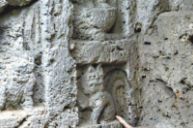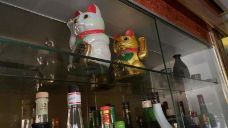Lucky Cat goes global
In 2014, a tomb from the Northern Wei dynasty (386-534) was found in Shaanxi, China. In the tomb, a statue of a cat washing its face was found. [cf] The statue shows striking similarities to the modern version of the Lucky Cat. The idea of a cat washing its face has been associated in China with good signs, which was described by the Chinese Tang dynasty writer (618-907) Duan Chengshi (806-863): “If a cat washes his ear, a visitor will come.”[cf] Chinese clearly have their own history with the Lucky Cat, Zhaocaimao 招财猫 in Chinese, but the cat nevertheless came from Japan.
Why is it then that we often associate the cat with China? Before the arrival of the Lucky Cat, Chinese society already had a God of Wealth, who could take on various forms. Though the cat is not part of the Chinese zodiac signs (the cat was outsmarted by the rat, hence the cat’s passion for hunting rats), the link of the Lucky Cat with wealth was a way in which the Chinese gave the cat a special place in society. Being a symbol of good fortune and wealth, the Lucky Cat was quickly adopted in Chinese society, and easily fit in the Chinese practice of giving symbolic meaning to objects and animals.
In the 1920s, the Japanese Lucky Cat was exported to China for the first time, and was made specially for the Chinese market. [cf] The contemporary Lucky Cat statue became more popular after the 1980s. [Hu 107] Taiwan and Hong Kong had already seen the Lucky Cat statues brought over from Japan in the years prior. Taiwan, sharing a colonial past with Japan, may have been introduced to the cat statue between 1895 and 1945.[ibid] Hong Kong, being a more open market in comparison to mainland China, was introduced to the Lucky Cat through the distribution of Japanese goods during the Japanese economic miracle. In the Taiwanese case, the Lucky Cat has even taken on diplomatic duties, since Tsai Ing-wen received a statue from Japanese diplomats, which was a way for the Japanese to show friendship and good fortune blessings.[cf]
Companies from Hong Kong and Taiwan set up factories in the mainland after China opened up in 1978. These companies produced the Lucky Cat, and in the process it started to become more popular in China.[Hu 107-8] Interestingly enough, the cat did not serve as much of a religious function as the God of Wealth, but it simply became associated with wealth. The name, Zhaocaimao 招财猫, reflects this: zhaocai 招财 means ‘to invite wealth’, and mao 猫 means cat. The Chinese name for the Lucky Cat can thus be roughly translated to ‘wealth inviting cat’.
Chinese immigrants in the Netherlands brought the Lucky Cat with them, and placed them in their homes, shops, and restaurants.


